Trade Kevin Love? History shows dangers of dealing NBA superstars
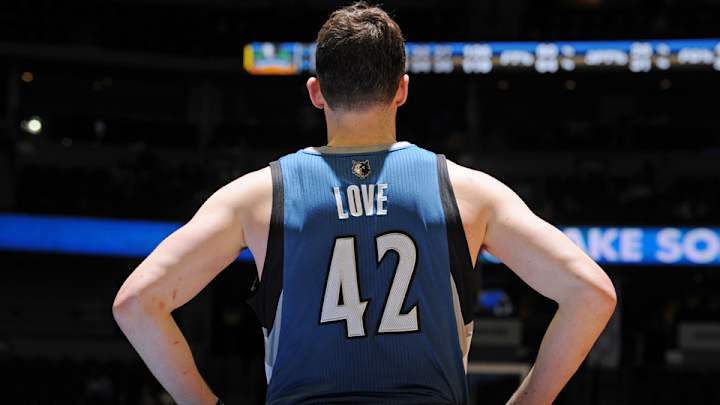
To be a superstar in the NBA is more than a declaration of basketball proficiency. It's a statement of exercisable power. Players of a certain class now have the ability to hand-select their team, regardless of contract status. In 2011, Carmelo Anthony's camp dropped hints about landing in New York until Denver made it so. In 2012, Dwight Howard's representatives lobbied for a move to the Lakers until he wore purple and gold. Free agency, it seems, is only one available vehicle for the league's best players to change teams.
As such, it's never been more important to understand the going rate of a superstar. That very topic manifests in the circus surrounding Kevin Love, most often in discussions of whether the Timberwolves should prefer Cavaliers No. 1 pick Andrew Wiggins or Warriors shooting guard Klay Thompson or some other prospective trade return. Underneath the specifics, such debates are a conversation regarding what assets Minnesota should prioritize. There is no consensus answer that can be applied to all teams in similar situations. But there's enough recent precedent to consider where different trade packages have left teams forced into dealing a star.
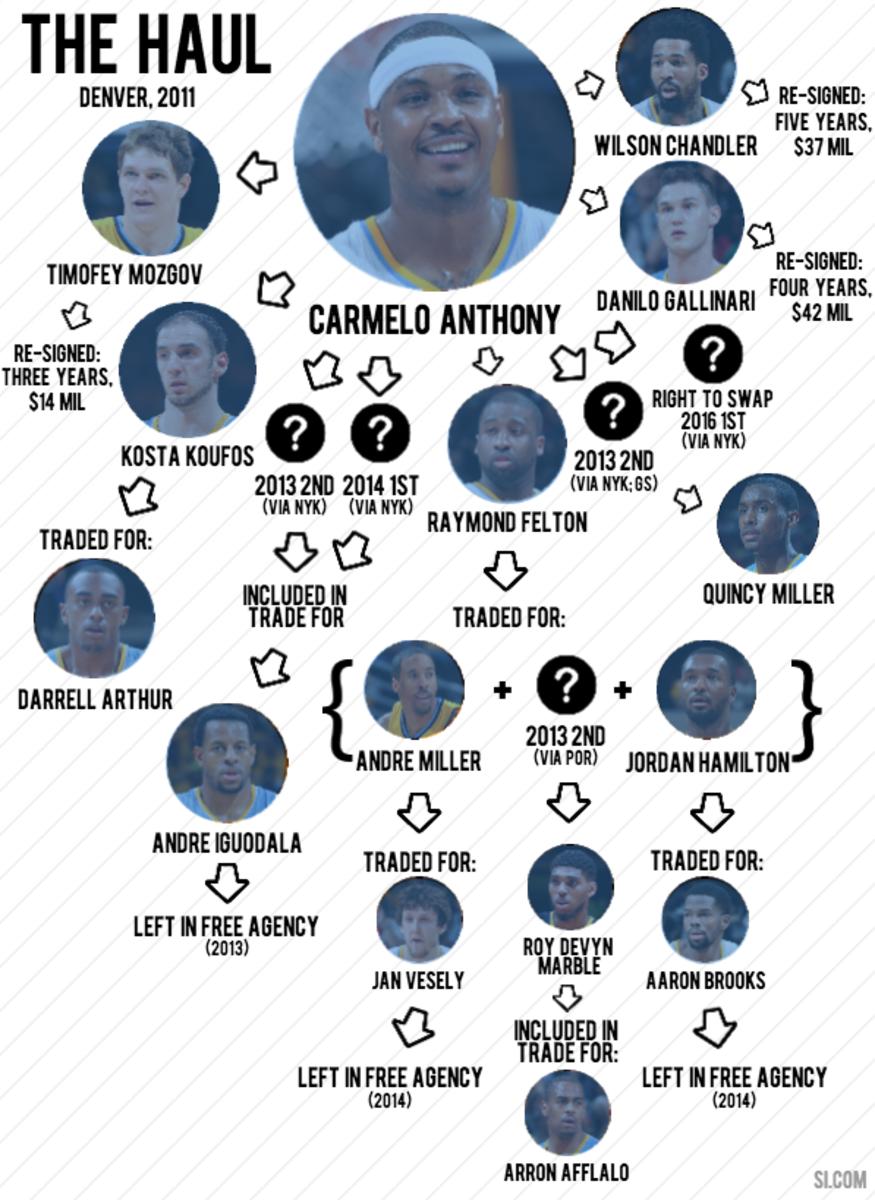
Carmelo Anthony (2011)
Nuggets acquired:Danilo Gallinari, Wilson Chandler, Raymond Felton, Timofey Mozgov, Kosta Koufos, a 2014 first-round pick and two second-round picks (2012 and 2013)
Nuggets traded: Carmelo Anthony, Chauncey Billups, Anthony Carter, Shelden Williams, Renaldo Balkman and a 2015 second-round pick
Anthony's move from the Nuggets to the Knicks in many ways set the standard for superstar movement: It enabled a talented player to leverage his early-termination option to force a trade, it showed that enough moderate mid-level assets can entice a team in Denver's position and it proved that contract flexibility allows players to guide their exodus to a particular team. If the Nuggets wanted to get the best return possible on Anthony, they had little choice but to send him to the Knicks. Any other result likely would have ended up in Anthony's exercising his option to become a free agent in the summer of 2011, scaring away those suitors who might otherwise have paid up to acquire a star scorer.
Give and Go: NBA's offseason winners
As a result, Denver received the best collection of good-not-great pieces that New York could muster. Gallinari was the closest to a potential star, though he didn't resemble a first-option scorer and has been plagued by injuries since the trade. Chandler and Felton were quality starters on reasonable contracts, thought to keep the Nuggets in the playoff hunt and flexible to make further moves. That next, franchise-changing deal never really materialized. The return on Melo has kept Denver from collapsing, but the pieces acquired were never repackaged to land a transformational talent. Those players who did well for the Nuggets were re-signed; those who did not were sent elsewhere in a series of relatively minor trades.
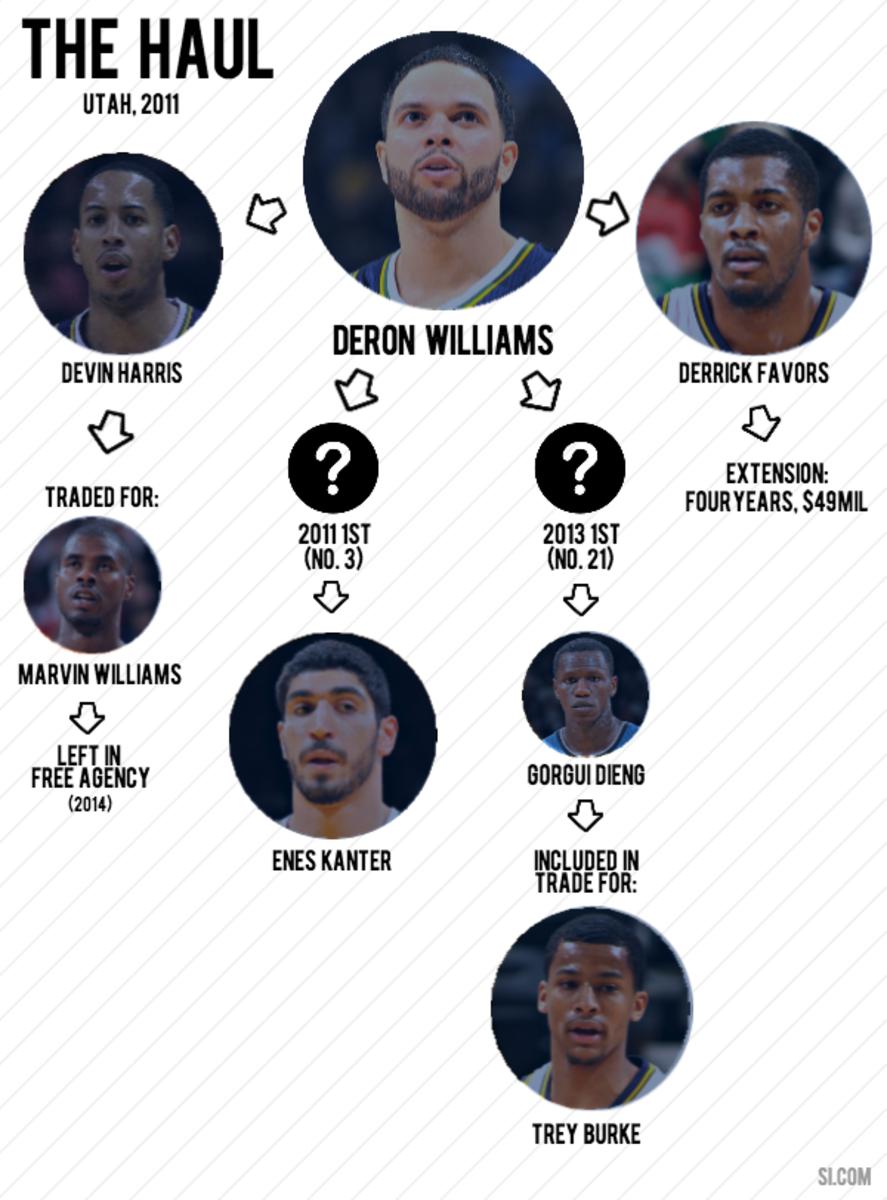
Deron Williams (2011)
Jazz acquired:Derrick Favors, Devin Harris, a 2011 first-round pick (No. 3) and a 2013 first-round pick (No. 21)
Jazz traded:Deron Williams
From a public perspective, Williams' exit came together in a flash. The legendary Jerry Sloan had resigned as Jazz coach only two weeks earlier, for reasons that allegedly involved Williams. Anthony was sent to the Knicks in the same week, following months of rumor mongering. Then, Williams was dealt swiftly for a return that scored the No. 3 pick in the most recent draft (Favors), two future first-round picks and Harris, a quality lead guard and former All-Star. Regardless of the role Utah envisioned for Harris, Favors was the kind of high-ceiling prospect that the Nuggets had failed to obtain for Anthony.
Favors hasn't quite made good on that promise, but at 23 he's quietly grown into one of the league's better pick-and-roll players and an influential rim protector. He could be a star yet, insofar as we include his defense and rebounding in such evaluations. The accompanying first-round picks have both panned out in interesting ways. With the 2011 choice, Utah (selecting in New Jersey's stead) vaulted up to the third pick in the lottery from the sixth position. It grabbed Kanter, who has hit an early plateau as a merely solid NBA big man. The 2013 first-round pick was eventually packaged (with the rights to Shabazz Muhammad) to acquire point guard Trey Burke, whose prospects are bright, but uncertain.
This is the problem we run into in evaluating the Jazz's return: While the package of veterans Denver received for Anthony could be judged based on measurables like record and playoff appearances, many of the pieces Utah landed in the Williams deal are still developing. Favors, Burke and Kanter are the remnants of the original deal and core members of the Jazz's current roster; they haven't blossomed to the point of pulling Utah out of the gutter, but all three youngsters still project value in their potential.
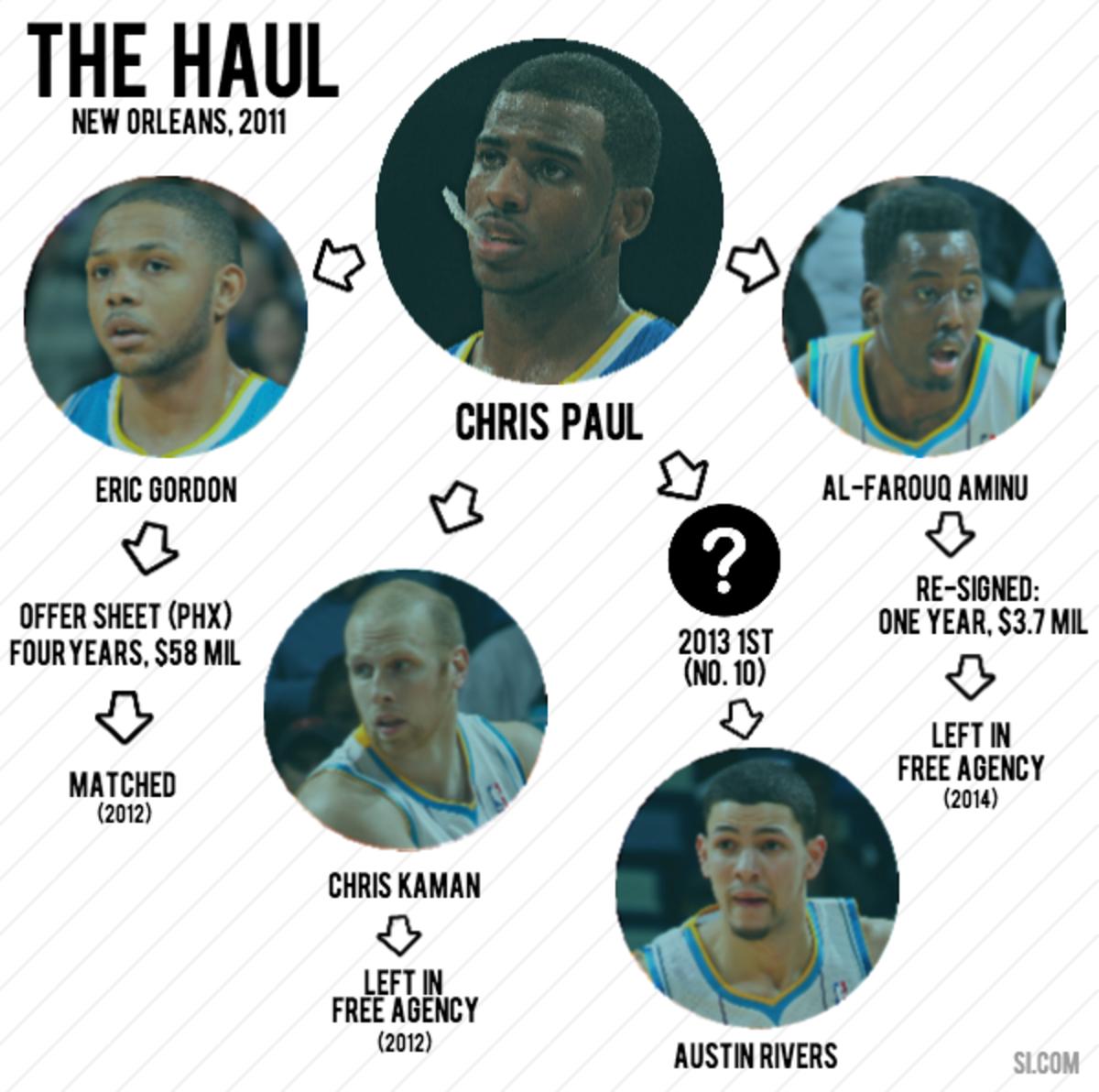
Chris Paul (2011)
Hornets/Pelicans acquired:Eric Gordon, Chris Kaman, Al-Farouq Aminu and a 2012 first-round pick (via Minnesota; No. 10)
Hornets/Pelicans traded: Paul, two second-round picks (both 2015)
The best-laid plans of the then-Hornets have all but perished. On paper, this was a promising return. New Orleans received a budding star in Gordon and a first-round pick, which had belonged to the Wolves and was unprotected. That could be the basis of a strong core, provided that the Hornets nailed the pick and found good use or good returns for the other veterans on the roster.
Give and Go: NBA's offseason losers
That framework broke down in two fundamental ways. First, after Gordon played just nine games in an injury-derailed 2011-12 season, the Hornets were forced to make a $58 million decision regarding his future. That was the price of the four-year offer sheet that the restricted free-agent shooting guard signed with the Suns, positioning the Hornets to either match or see a prized piece of Paul's return go for nothing. New Orleans matched, signing a disgruntled and oft-injured Gordon to one of the worst contracts in the league.
Second, Minnesota -- a team whose success would define the value of the first-rounder acquired -- fared well enough in the lockout-shortened season to make matters difficult for New Orleans. This was in part due to a glut of similar performance; notwithstanding the uniquely dreadful 7-59 Bobcats, the rest of the NBA's 10 worst teams all fell between 20 and 26 wins. On the high end were the Wolves, were 10th worst at 26-40. That was a much lower pick than anticipated, made worse by the fact that New Orleans selected the seldom-effective Austin Rivers. There's still time for Rivers to grow into a productive player, but his first two seasons have offered only a smattering of hope.
It's tempting, in retrospect, to allege that the Hornets may have been better off accepting the proposed three-team deal with the Lakers and Rockets that would have netted the Hornets Goran Dragic, Kevin Martin, Luis Scola, Lamar Odom and a 2012 first-round pick (via New York). Had the NBA approved the trade, however, New Orleans would not have been bad enough to luck into the right to select No. 1 pick Anthony Davis in the following draft. Such is an important consideration in evaluating prospect-laden returns: Part of the package, it seems, is bottoming out quickly enough to land a potential star in subsequent drafts.
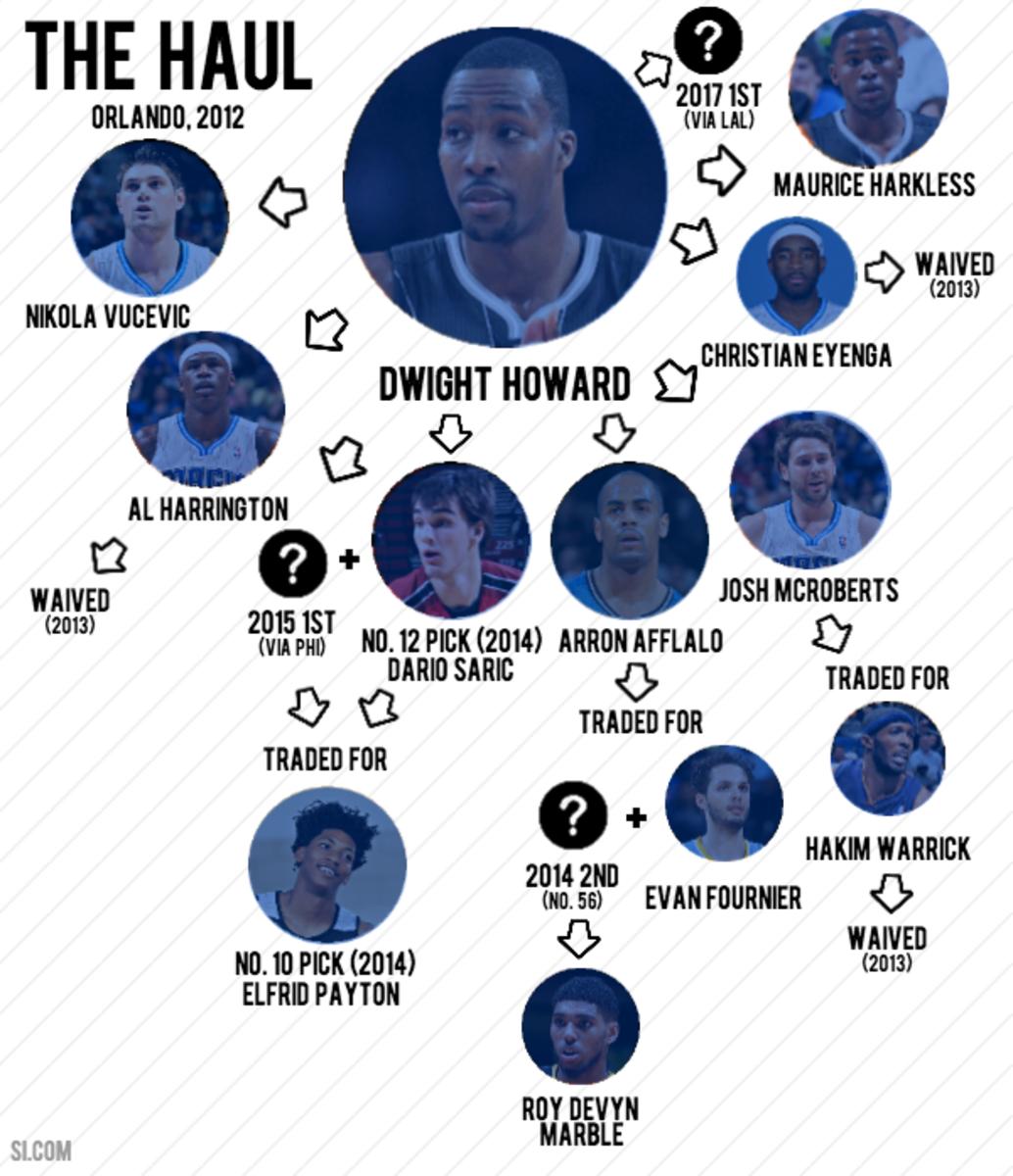
Dwight Howard (2012)
Magic acquired:Nikola Vucevic, Arron Afflalo, Josh McRoberts, Al Harrington, the rights to Maurice Harkless, Christian Eyenga, a 2014 first-round pick (via Denver; No. 12), a 2015 first-round pick (via Philadelphia), a 2017 first-round pick (via Lakers) and two second-round picks (2013 and 2015)
Magic traded: Dwight Howard, Earl Clark, Chris Duhon, Jason Richardson
This package for Howard is substantial, but it could end up comparable to the Nuggets' return on Anthony. To this point only Afflalo has been an All-Star-caliber player, and he only qualifies because he played at a bone-dry position in a historically weak conference last season. Vucevic is a nice player but might never be a foundational talent. Harkless hasn't shown the defensive refinement or offensive polish to be much of a weapon (though he's only 21 and still raw). What, then, separates this lot from the platter of Gallinari, Chandler, Felton, etc., that Denver received?
To those who believe it to be the draft picks, consider that two of the three first-rounders acquired here were used so that the Magic could select Elfrid Payton with the No. 10 pick in the 2014 draft. Concerned that Payton wouldn't be available at No. 12, Orlando sent that selection to Philadelphia and returned the Sixers' protected 2015 first-rounder in order to move up to 10. The protection on the other first-round pick surrendered was built to sustain for at least a few years and at not point would have conveyed as a top-eight selection. If Payton pans out as a quality lead guard, perhaps he'll be worth the price of a mid-first-round pick or so.
If not, that puts a lot of pressure on Vucevic, Harkless or the Lakers' 2017 first-round pick to become an asset of notable value. That Lakers pick, too, comes with a catch: It's return is predicated on the resolution of another of L.A.'s debts. Because of the spending spree that went into their now-dissolved superteam, the Lakers also owe a top-five-protected first-round pick to Phoenix. That pick is set to convey in 2015. If it does not convey (i.e., if the Lakers land in the top five of the draft lottery), then the 2017 pick owed to Orlando will instead default as two second-rounders. To simplify:
• If the Lakers end up with a pick in the 1-5 range in the 2015 draft, they keep their pick, their debt to the Suns will roll into next season (with top-three protection) and their debt to the Magic will convey as two second-round picks (2017 and 2018).
• If the Lakers do not end up with a pick in the 1-5 range of the 2015 draft, the Suns get their pick and the Lakers will owe the Magic a top-five-protected first-rounder in 2017.
Are these weird, mismatched Lakers bad enough to secure one of the top picks in the draft? A central part of the Magic's return on Howard hangs in the balance.
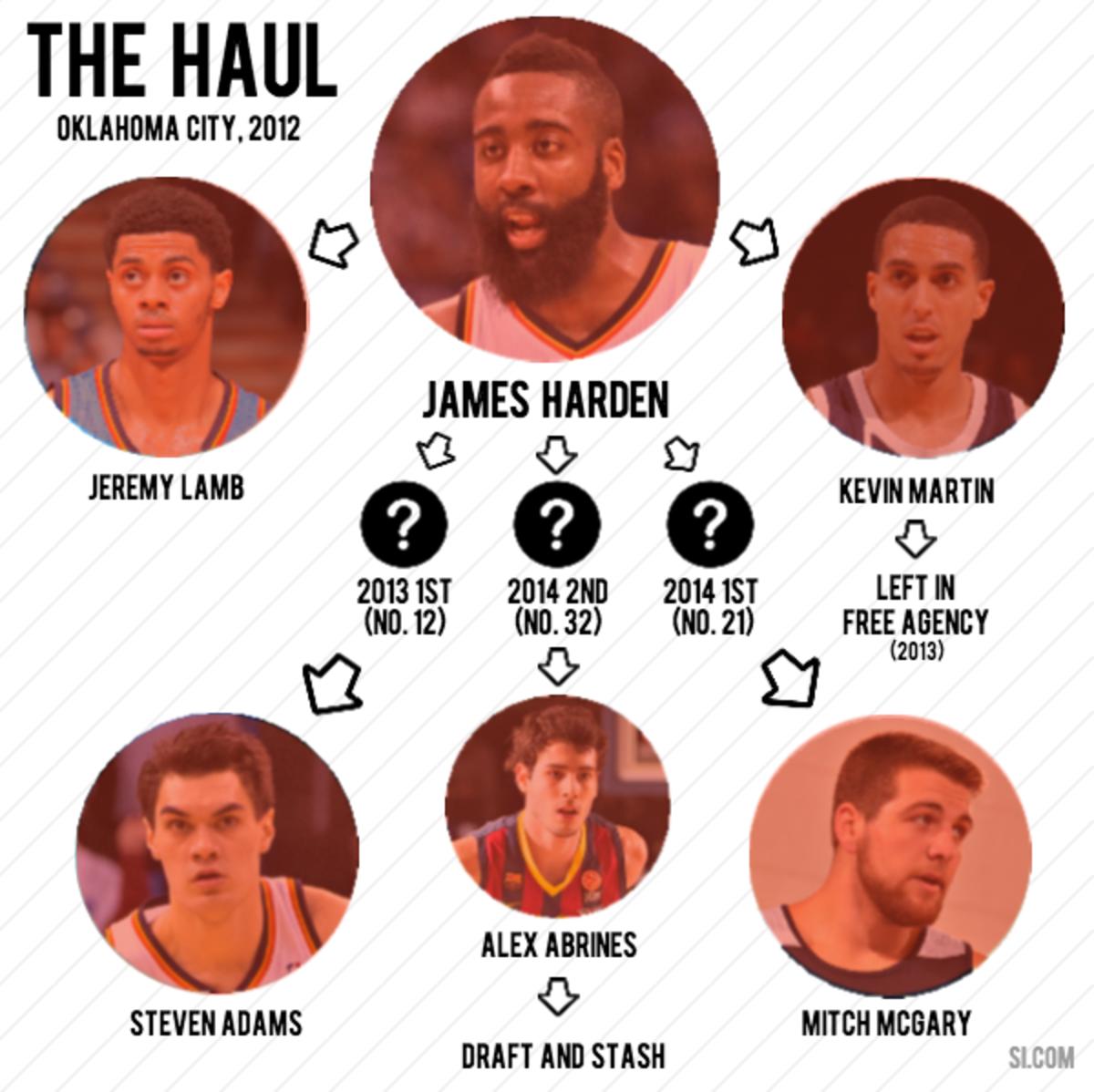
James Harden (2012)
Thunder acquired: Kevin Martin, Jeremy Lamb, lottery guaranteed 2013 first-round pick (via Toronto; No. 12), 2014 first-round pick (No. 21) and a 2014 second-round pick
Thunder traded: James Harden, Cole Aldrich, Daequan Cook, Lazar Hayward
This is an unusual case, for many reasons, not least of which that Harden was only his team's third-best player. Oklahoma City also wasn't in a position to deal dollar-for-dollar in terms of value, as the luxury-tax implications of Harden's looming extension provided part of the reason for trading him. The goal of a return, then, would be the acquisition of good, cheap pieces able to complement Kevin Durant and Russell Westbrook. Such restrictions point heavily to rookie-scale deals, as a good-to-great player in the first four years of his NBA career provides the best value possible.
Oklahoma City swung for three potential rookie-scale additions here, along with Martin to work as a stopgap. Martin lived up to his end of the bargain in his final year under contract before moving to Minnesota in free agency. Lamb, 22, has had his moments but nothing more yet. A good portion of this return would be set in potential picks, one of which (originally from the Raptors) was structured to guarantee a lottery pick.
That it did, and the Thunder are likely quite pleased with Steven Adams -- the physical, 21-year-old center they snagged with the No. 12 pick in 2013. Still, the fact that OKC was in a position to pick so late was representative of an unfortunate turn of events. The Raptors opened the 2012-13 season only 16-30, at which point they traded for Rudy Gay, who helped lift Toronto to a .500 record the rest of the season. If the Raptors had sustained their first-half winning percentage, the pick owed to Oklahoma City would have fallen between 6-7. Instead, the pick fell to 12, all as a result of the actions of a front office halfway across the league.
It's impossible to delve into these kinds of counterfactuals with any certainty, but I'd wager that this deal might be discussed differently had the Thunder landed, say, Nerlens Noel with Toronto's pick. The analytical calculus also might have changed if Michael Carter-Williams had been drafted as Westbrook's combo-guard counterpart or if Kentavious Caldwell-Pope had filled in between Westbrook and Durant on the wing.
What's most important in the Harden case, though, isn't some reflection of what might have been. It's a reminder of the greater influence of the unknown. Teams in a position to deal a star can carefully engineer the perfect trade package, fit with prospects and picks and able veterans. So much of the final judgment, though, comes down to factors far beyond their control. Other teams will zig and zag in a way that influences draft pick value. The lottery balls will bounce to create or diminish opportunity. There's only so much that can be done to hedge against risk, as trading a sure-thing superstar necessarily veers into uncertainty.
Photos in all graphics courtesy of NBAE/Getty Images.
